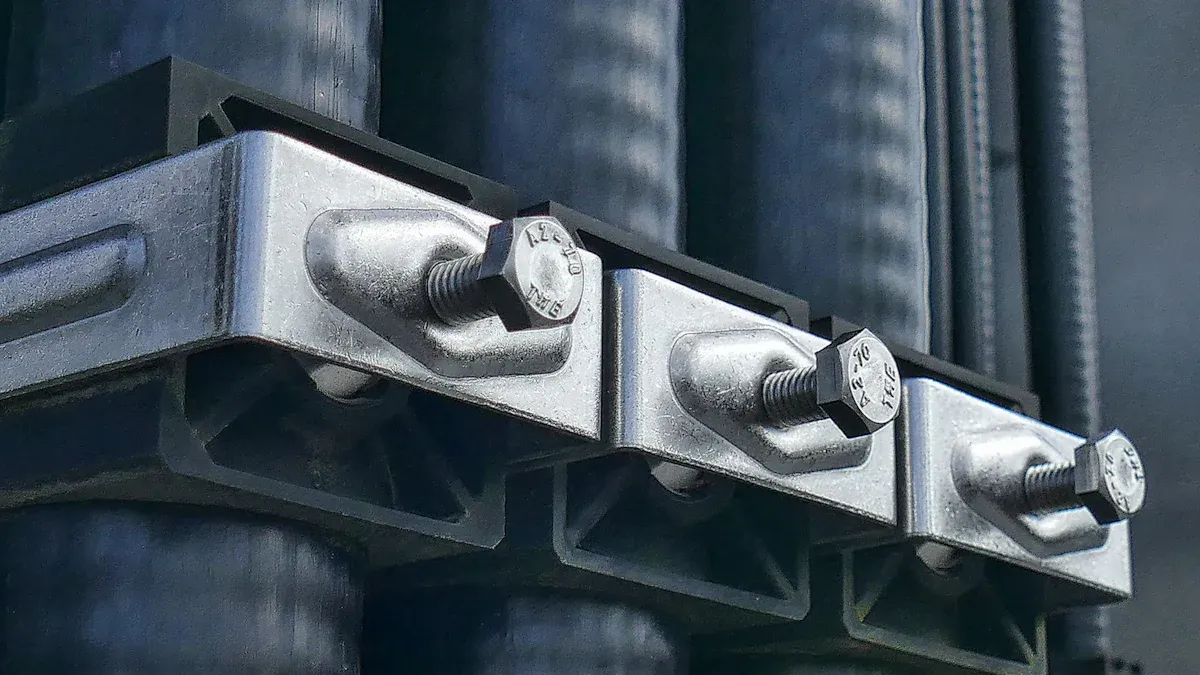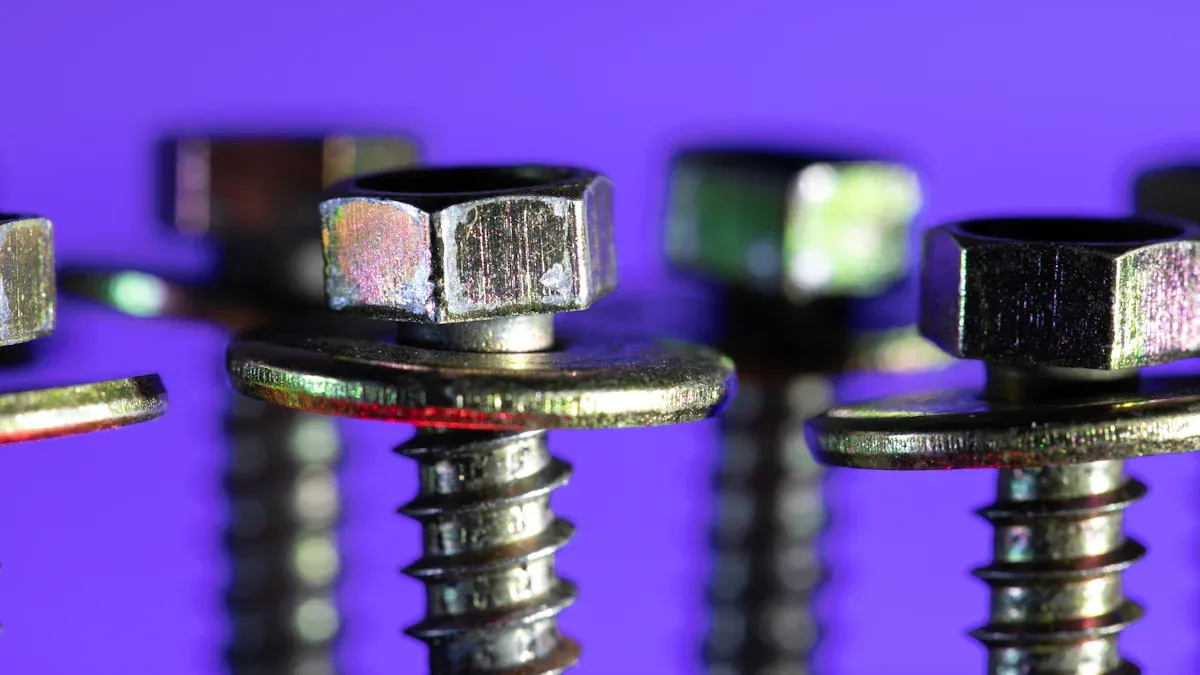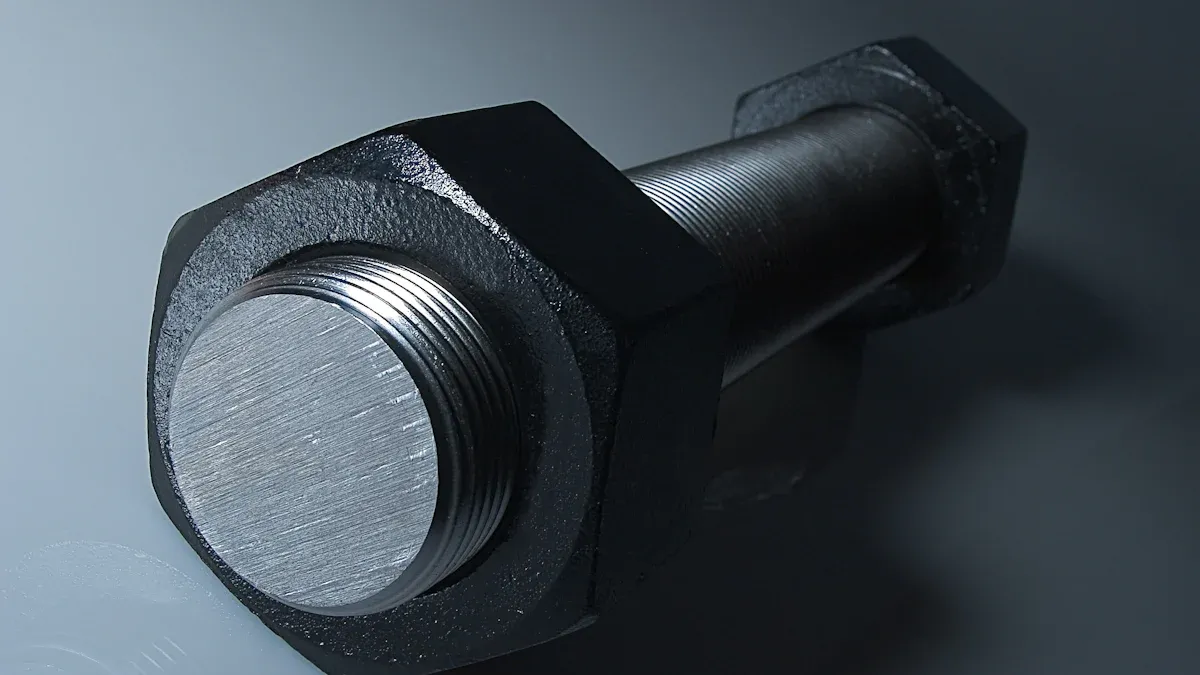
Fasteners play a critical role in construction and machinery. Hexagonal bolts, known for their six-sided heads, are versatile and commonly used in general applications. Heavy-Duty Track Bolts, specifically designed for high-stress environments like railway tracks or heavy equipment, are a type of heavy-duty hexagonal bolt that ensures durability and strength. Choosing the right fastener, including heavy-duty hexagonal bolts, ensures safety, efficiency, and long-term performance.
Key Takeaways
- Hexagonal bolts are useful and work well for common tasks. They are great for projects with normal weight needs.
- Heavy-Duty Track Bolts are very strong and last a long time. They are important for tough jobs like trains and big machines.
- Picking the right bolt means thinking about project needs, weather, and weight. This helps keep things safe and working for a long time.
Overview of Hexagonal Bolts

What Are Hexagonal Bolts?
Hexagonal bolts, often referred to as hex bolts, are fasteners with a six-sided head. This design allows for easy gripping with tools like wrenches or sockets, ensuring a secure fit. These bolts are typically made from materials such as stainless steel, carbon steel, or alloy steel, offering varying levels of strength and corrosion resistance. Their threaded shafts make them suitable for use with nuts or directly into tapped holes.
Common Uses of Hexagonal Bolts
Hexagonal bolts are widely used across multiple industries due to their versatility. In the Asia-Pacific region, they play a key role in electric vehicle battery pack installations and electronics assembly. Europe relies on them for machinery and renewable energy applications, including wind turbines. North America uses them extensively in aerospace maintenance, particularly for airframe fastener replacements. In Latin America, they are essential for mining equipment rebuilds and heavy-duty conveyor systems. The Middle East incorporates hexagonal bolts in prefabricated construction projects and modular steel framing.
| Region | Growth Rate | Key Applications |
|---|---|---|
| Asia-Pacific | 17% | Electric vehicle battery pack installations, automotive, electronics assembly |
| Europe | N/A | Machinery and renewable energy sectors, wind turbine manufacturers |
| North America | 42% | Aerospace maintenance applications, airframe fastener replacements |
| Southeast Asia | 20-25% | Consumer electronics manufacturing, smartphone motherboard retention |
| Latin America | 40% | Mining equipment rebuilds, heavy-duty conveyor system components |
| Middle East | N/A | Prefabricated construction projects, steel framing connections in modular buildings |
Advantages of Hexagonal Bolts
Hexagonal bolts offer several advantages. Their six-sided head provides excellent grip, making installation and removal efficient. They are available in various sizes and materials, catering to diverse project requirements. Their durability ensures long-term performance, even under significant stress. Additionally, they are compatible with a wide range of tools, enhancing their usability in different environments.
Limitations of Hexagonal Bolts
While hexagonal bolts are versatile, they may not always meet the demands of high-stress applications. For instance, environments requiring exceptional strength and durability, such as railway tracks or heavy machinery, often necessitate specialized fasteners like heavy-duty track bolts. Furthermore, improper installation or material selection can compromise their performance, emphasizing the need for careful planning.
Overview of Heavy-Duty Track Bolts

What Are Heavy-Duty Track Bolts?
Heavy-Duty Track Bolts are specialized fasteners designed for applications requiring exceptional strength and durability. These bolts feature a robust design that withstands high levels of stress and vibration. Typically made from hardened steel or alloy materials, they offer superior resistance to wear and corrosion. Their unique threading and head design ensure a secure fit, even in demanding environments like railway tracks or heavy machinery.
Common Uses of Heavy-Duty Track Bolts
Heavy-Duty Track Bolts serve critical roles in industries where reliability is paramount. In railway systems, they secure rails to sleepers, ensuring stability under constant load and vibration. Construction projects use these bolts to fasten structural components in bridges and tunnels. Heavy equipment manufacturers rely on them for assembling machinery that operates under extreme conditions. Mining operations utilize these bolts to reinforce conveyor systems and drilling rigs, enhancing safety and performance.
Advantages of Heavy-Duty Track Bolts
Heavy-Duty Track Bolts provide unmatched strength and durability. Their ability to resist wear and corrosion makes them ideal for harsh environments. The bolts maintain structural integrity under heavy loads, reducing the risk of failure. Their compatibility with specialized tools simplifies installation, saving time and effort. Manufacturers like Ningbo Digtech (YH) Machinery Co.,Ltd. produce high-quality Heavy-Duty Track Bolts that meet industry standards, ensuring reliability and long-term performance.
Limitations of Heavy-Duty Track Bolts
While Heavy-Duty Track Bolts excel in high-stress applications, they may not be suitable for lighter tasks. Their robust design often requires specialized tools for installation, which can increase setup time. Additionally, their cost may be higher compared to standard fasteners, making them less economical for projects with minimal load requirements. Consulting experts like Ningbo Digtech (YH) Machinery Co.,Ltd. helps determine whether these bolts align with specific project needs.
Key Comparison Factors
Strength and Durability
Strength and durability are critical factors when selecting fasteners. Hexagonal bolts and Heavy-Duty Track Bolts differ significantly in their ability to withstand stress and environmental conditions. Heavy-Duty Track Bolts excel in high-stress environments due to their robust design and material composition. These bolts are often made from hardened steel or alloy materials, which provide superior resistance to wear and corrosion.
To evaluate the strength and durability of fasteners, engineers rely on material strength tests and durability analyses. The following table highlights key properties used to assess fasteners:
| Property | Description |
|---|---|
| Ultimate Tensile Strength | Measures the maximum stress a material can withstand while being stretched or pulled. |
| Ultimate Yield Strength | Indicates the maximum stress a material can endure before permanent deformation occurs. |
| Young’s Modulus | Reflects the material’s stiffness, calculated as the ratio of stress to strain. |
| Metal Elongation | Represents the degree to which a material can be stretched before breaking. |
| Tensile Elasticity | Describes the ability of a material to return to its original shape after deformation. |
| Plastic Deformation | Refers to the permanent distortion of a material when subjected to stress beyond its yield point. |
Different materials respond uniquely to stress. Homogeneous materials like untreated steel exhibit consistent behavior, while anisotropic materials, such as wood, have preferential planes of weakness. This distinction influences the choice of fasteners and their performance under load. Heavy-Duty Track Bolts, designed for extreme conditions, maintain structural integrity even under heavy loads, making them ideal for applications like railway tracks and heavy machinery.
Cost Considerations
Cost plays a significant role in fastener selection. Hexagonal bolts are generally more affordable due to their widespread availability and simpler manufacturing process. They are suitable for projects with standard load requirements and limited budgets.
Heavy-Duty Track Bolts, on the other hand, are more expensive due to their specialized design and material composition. Their higher cost is justified by their superior performance in demanding environments. For projects requiring exceptional strength and durability, the investment in Heavy-Duty Track Bolts ensures long-term reliability and reduces the risk of failure. Consulting manufacturers like Ningbo Digtech (YH) Machinery Co.,Ltd. can help determine the most cost-effective solution for specific applications.
Application-Specific Needs
The choice between hexagonal bolts and Heavy-Duty Track Bolts depends on the specific requirements of the project. Hexagonal bolts are versatile and suitable for general applications, such as machinery assembly, construction, and automotive repairs. Their compatibility with various tools and materials makes them a popular choice across industries.
Heavy-Duty Track Bolts are designed for specialized applications that demand exceptional strength and resistance to wear. Industries like railway systems, mining, and heavy equipment manufacturing rely on these bolts to secure critical components. Their ability to withstand high levels of stress and vibration ensures safety and performance in challenging environments.
Installation and Maintenance
Ease of installation and maintenance is another important consideration. Hexagonal bolts are straightforward to install and remove using standard tools like wrenches and sockets. Their simplicity makes them ideal for projects requiring frequent adjustments or replacements.
Heavy-Duty Track Bolts, while more robust, often require specialized tools for installation. This can increase setup time but ensures a secure fit in high-stress applications. Proper maintenance, including regular inspections and timely replacements, extends the lifespan of these bolts. Manufacturers like Ningbo Digtech (YH) Machinery Co.,Ltd. provide guidance on installation and maintenance practices to maximize the performance of Heavy-Duty Track Bolts.
How to Choose the Right Fastener
Assessing Project Requirements
Selecting the right fastener begins with understanding the specific needs of the project. Engineers and designers evaluate factors such as the type of materials being joined, the required strength of the connection, and the expected lifespan of the assembly. For projects requiring frequent disassembly, machine screws offer a practical solution due to their ease of removal. Structural applications often benefit from the robust connections provided by nuts and bolts. Each fastener type serves a unique purpose, making it essential to match the fastener to the project’s demands.
Evaluating Environmental Conditions
Environmental factors significantly influence fastener performance. Corrosive environments, such as those near saltwater or in chemical plants, require fasteners made from materials resistant to rust and degradation. Stainless steel and alloy fasteners excel in these conditions, ensuring long-term reliability. In high-temperature settings, heat-set inserts create durable threaded holes that withstand thermal expansion. Designers must consider humidity, temperature, and exposure to chemicals when choosing fasteners to prevent premature failure.
Considering Load and Stress Factors
Load and stress play a critical role in fastener selection. Heavy-duty applications, such as securing railway tracks or assembling heavy machinery, demand fasteners capable of withstanding extreme forces. Heavy-Duty Track Bolts, for example, maintain structural integrity under constant vibration and heavy loads. For lighter applications, self-tapping screws work well with materials like ABS or PETG, where threading isn’t feasible. Engineers analyze stress distribution and load-bearing capacity to ensure the fastener can handle the demands of the project.
Balancing Cost and Performance
Cost considerations often influence fastener selection. While hexagonal bolts are more affordable and versatile, specialized fasteners like Heavy-Duty Track Bolts justify their higher cost through superior performance in demanding environments. Balancing cost and performance requires evaluating the long-term benefits of investing in durable fasteners. Projects with minimal load requirements may opt for standard fasteners to reduce expenses, while high-stress applications prioritize reliability over initial cost.
Consulting Experts or Manufacturers
Consulting industry experts or manufacturers ensures informed decision-making. Professionals like Ningbo Digtech (YH) Machinery Co.,Ltd. provide valuable insights into fastener selection, offering guidance on material compatibility, load capacity, and environmental suitability. Manufacturers also supply technical specifications and installation recommendations, helping engineers optimize fastener performance. Collaboration with experts minimizes risks and ensures the chosen fastener meets project requirements.
Choosing the right fastener depends on understanding the differences between hexagonal bolts and heavy-duty track bolts. Hexagonal bolts offer versatility for general applications, while heavy-duty track bolts excel in high-stress environments.
Selecting the correct fastener ensures safety, efficiency, and long-term reliability. Manufacturers like Ningbo Digtech (YH) Machinery Co.,Ltd. provide expert guidance to help professionals make informed decisions tailored to their project needs.
FAQ
What is the main difference between hexagonal bolts and heavy-duty track bolts?
Hexagonal bolts are versatile for general use. Heavy-duty track bolts offer superior strength and durability for high-stress applications like railway systems or heavy machinery.
How can environmental conditions affect fastener performance?
Corrosive environments demand rust-resistant materials like stainless steel. High temperatures require heat-resistant fasteners to prevent deformation or failure.
Why consult manufacturers like Ningbo Digtech (YH) Machinery Co.,Ltd.?
Manufacturers provide expert advice, technical specifications, and installation guidance, ensuring fasteners meet project requirements and perform reliably under stress.
Post time: May-16-2025